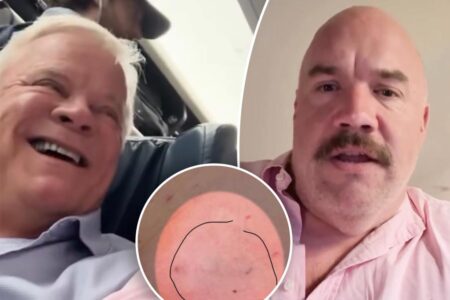True confidence comes from within, not from a syringe.
At just 25, Christopher Sharratt, from Staffordshire, UK, is opening up about his journey through the world of extreme cosmetic procedures — and the life-changing decision to undo it all. In a series of shocking before-and-after photos, Sharratt shares how years of lip and facial fillers led to exaggerated features and facial swelling, before he decided to reverse the effects and reclaim his natural look.
Twenty-five-year-old Christopher Sharratt, who initially underwent his first filler injections at age 17, estimates he spent around £3,500 (roughly $4,400) on cosmetic enhancements.
It all began after he lied about his age to get the treatments, and what started as a small step quickly snowballed into a full-blown addiction to injectables.
“The amount of money I spent on that is like half a house deposit, for God’s sake,” Sharratt, from Staffordshire, UK, told Newsweek, reflecting on how much money he spent.
The real kicker, however, was the immediate satisfaction he got from the swelling that followed each injection. “You have a mil [millimeter] and your lips swell up or wherever you have it on your face. And you’re like, oh my God, this swelling looks so good. And a week later, the swelling goes down and you’re like, oh c***, I need to go and get another mil,” he confessed.
Dr. Cali Estes, a psychologist and addiction expert, explained that while fillers are not chemically addictive, they can become psychologically addictive. “Each injection gives an instant confidence boost, and the brain starts chasing that dopamine hit again—just like checking likes on social media,” Estes said.
For Sharratt, the cycle was all too familiar, leading him to lose sight of how much he had altered his appearance.
Dr. Estes calls this phenomenon “aesthetic blindness,” where people who start using fillers stop noticing the changes as they accumulate. “The brain recalibrates so quickly that what once looked dramatic now feels normal. They stop seeing the enhancements and keep chasing more,” she said.
For Sharratt, the tipping point came during the COVID-19 lockdown, when he was unable to access filler treatments. Looking at photos of himself from the past, he had an epiphany: “I actually didn’t look that bad. I should have been a bit nicer to myself,” he reflected.
Sharratt’s decision to undo years of facial modifications wasn’t easy. It took four rounds of dissolver injections — painful and time-consuming — to remove the filler. “I had four rounds of dissolver because I had so much filler in my lip,” he said.
“Cheeks and jaw were easy to get rid of, but I actually had to start pulling my lips out and putting it in the back because there was nowhere else to fill out,” he said. “It did take four whole rounds of dissolving to get rid of it.”
But the process wasn’t just physically draining — it was emotionally taxing too. Sharratt now hopes that sharing his story will raise awareness about the risks of cosmetic procedures and inspire a push for stricter regulations.
One of Sharratt’s biggest concerns is the lack of oversight in the UK, where fillers are often administered in salons without medical supervision. “There needs to be so much more regulation in place,” he said. “No 17-year-old should be going to get fillers. Nobody.”
In the United States, dermal fillers are regulated by the FDA, which has set age restrictions and guidelines for their use. In general, fillers are approved only for adults, with certain products cleared for individuals aged 21 and older. Licensed medical professionals, including doctors and nurses, are the only ones allowed to administer these injections in most states.
Unfortunately, Sharratt said that patients are rarely informed about the long-term risks associated with fillers. “Nobody tells you that it doesn’t dissolve completely… It moves around your face,” he noted. “You don’t get told that if you overstretch your lips, parts of your face can remain stretched.”
Dr. Estes emphasized the medical risks of fillers, which can include complications like blindness. She also pointed out the danger for individuals with body dysmorphia or addiction tendencies, urging that there needs to be more psychological screening and ethical limits in place to protect vulnerable individuals.
Now that he’s filler-free, Sharratt says he feels more confident and approachable than ever before. “More people come up to me now than ever,” he said. “People wouldn’t come up and say hello before.”
He hopes his story will serve as a cautionary tale and spark a broader conversation about the dangers of cosmetic procedures. “Hopefully I can be one of the few people to put their hand up, say I’ve made a mistake, and we need to do something about this,” he said.
In a world where the pressure to look “perfect” is ever-present, Sharratt’s story offers a reminder that sometimes, less is more.
Read the full article here














